The Nitrate Cellulose Negatives: Degradation Study via Chemometric Methods
Abstract
:1. Introduction
2. Methodological Part
2.1. Photographic Negatives
2.2. Raman Spectroscopy
2.3. IR Spectroscopy
2.4. Digital Photography
2.5. Chemometric Methods
2.5.1. Data Preprocessing
2.5.2. Hierarchical Cluster Analysis
2.5.3. SVM Classification
3. Results and Discussion
3.1. Raman and IR Spectroscopy
3.2. Chemometric Analysis
3.2.1. Hierarchical Cluster Analysis of Photographic Materials
3.2.2. Support Vector Machine Classification
4. Conclusions
Supplementary Materials
Author Contributions
Funding
Data Availability Statement
Acknowledgments
Conflicts of Interest
References
- Caraffa, C. The photo archive as laboratory. Art history, photography, and materiality. Art. Libr. J. 2019, 44, 37–46. [Google Scholar] [CrossRef]
- Condorelli, F.; Rinaudo, F. Cultural Heritage Reconstruction from Historical Photographs and Videos. Int. Arch. Photogramm. Remote Sens. Spat. Inf. Sci. 2018, 42, 259–265. [Google Scholar] [CrossRef]
- Mäkelä, A.; Sederholm, N. The Memory of the Photograph: Cataloguing & Classification Practices in the Nordic Countries, the Baltic States and Russia [Internet]; Nordic Council of Ministers: Copenhagen, Denmark, 2001. [Google Scholar]
- Kull, C.A. Historical landscape repeat photography as a tool for land use change research. Nor. Geogr. Tidsskr. 2005, 59, 253–268. [Google Scholar] [CrossRef]
- Boito, C.; Birignani, C. Restoration in Architecture: First Dialogue. Future Anterior. 2009, 6, 68–83. [Google Scholar] [CrossRef]
- Bräuer-Burchardt, C.; Voss, K. Facade Reconstruction of Destroyed Buildings Using Historical Photographs. 2012. Available online: https://www.isprs.org/proceedings/xxxiv/5-c7/pdf/2001-22-cb04.pdf (accessed on 27 June 2024).
- Xie, I.; Matusiak, K.K. Digitization of text and still images. In Discover Digital Libraries; Elsevier: Amsterdam, The Netherlands, 2016; pp. 59–93. [Google Scholar]
- Neves, A.; Friedel, R.; Callapez, M.E.; Swank, S.D. Safeguarding our dentistry heritage: A study of the history and conservation of nineteenth–twentieth century dentures. Herit. Sci. 2023, 11, 142. [Google Scholar] [CrossRef]
- Edge, M.; Allen, N.S.; Hayes, M.; Riley, P.N.K.; Horie, C.V.; Luc-Gardette, J. Mechanisms of deterioration in cellulose nitrate base archival cinematograph film. Eur. Polym. J. 1990, 26, 623–630. [Google Scholar] [CrossRef]
- Quye, A. Quality Matters for Historical Plastics: The Past-Making of Cellulose Nitrates for Future Preservation. Cah. François Viète 2017, III-2, 45–65. [Google Scholar] [CrossRef]
- Moore, D.S.; McGrane, S.D. Comparative infrared and Raman spectroscopy of energetic polymers. J. Mol. Struct. 2003, 661–662, 561–566. [Google Scholar] [CrossRef]
- Neves, A.; Ramos, A.M.; Callapez, M.E.; Friedel, R.; Réfrégiers, M.; Thoury, M.; Melo, M.J. Novel markers to early detect degradation on cellulose nitrate-based heritage at the submicrometer level using synchrotron UV–VIS multispectral luminescence. Sci. Rep. 2021, 11, 20208. [Google Scholar] [CrossRef]
- Selwitz, C. Cellulose Nitrate in Conservation [Internet]; Getty Conservation Institute: Los Angeles, CA, USA, 1988. [Google Scholar]
- Rossell, D. Exploding Teeth, Unbreakable Sheets and Continuous Casting: Nitrocellulose from Gun-Cotton to Early Cinema; Fédération Internationale des Archives du Film: Brussels, Belgium, 2002; pp. 1–20. [Google Scholar]
- Greenberg, A.S.; Broder, S. The Story of Nitrocellulose. J. Pat. Off. Soc’y. 1925, 8, 517. [Google Scholar]
- Carter, E.A.; Swarbrick, B.; Harrison, T.M.; Ronai, L. Rapid identification of cellulose nitrate and cellulose acetate film in historic photograph collections. Herit. Sci. 2020, 8, 51. [Google Scholar] [CrossRef]
- Coccato, A.; Bersani, D.; Coudray, A.; Sanyova, J.; Moens, L.; Vandenabeele, P. Raman spectroscopy of green minerals and reaction products with an application in Cultural Heritage research. J. Raman Spectrosc. 2016, 47, 1429–1443. [Google Scholar] [CrossRef]
- Petrova, O.; Pankin, D.; Povolotckaia, A.; Borisov, E.; Krivul’ko, T.; Kurganov, N.; Kurochkin, A. Pigment palette study of the XIX century plafond painting by Raman spectroscopy. J. Cult. Herit. 2019, 37, 233–237. [Google Scholar] [CrossRef]
- Petrova, O.I.; Pankin, D.V.; Povolotckaia, A.V.; Borisov, E.V.; Beznosova, M.O.; Krivul’ko, T.A.; Kurochkin, A.V. Identification of Pigments in Colored Layers of a Painting by Raman Spectroscopy. Opt. Spectrosc. 2017, 123, 965–969. [Google Scholar] [CrossRef]
- Vandenabeele, P.; Moens, L.; Edwards, H.G.M.; Dams, R. Raman spectroscopic database of azo pigments and application to modern art studies. J. Raman Spectrosc. 2000, 31, 509–517. [Google Scholar] [CrossRef]
- Povolotckaia, A.; Pankin, D.; Kurganov, N.; Borisov, E.; Grigorieva, I.; Kurochkin, A. Xiongnu ancient nomad inlaid buckles (2nd-1st centuries BC): Multi-analytical research. J. Archaeol. Sci. Rep. 2023, 52, 104253. [Google Scholar] [CrossRef]
- Mazzeo, R.; Joseph, E.; Prati, S.; Millemaggi, A. Attenuated Total Reflection–Fourier transform infrared microspectroscopic mapping for the characterisation of paint cross-sections. Anal. Chim. Acta 2007, 599, 107–117. [Google Scholar] [CrossRef]
- Povolotckaia, A.; Korogodina, M.; Pankin, D.; Podkovyrova, V.; Kurganov, N.; Tileva, E.; Tseveleva, I.; Mikhailova, A.; Petrov, Y.; Povolotskiy, A.; et al. Investigation of the encapsulated XIIIth century French Legendarium F-403 from the Library of Russian Academy of Science. J. Cult. Herit. 2020, 46, 298–303. [Google Scholar] [CrossRef]
- De Gussem, K.; Vandenabeele, P.; Verbeken, A.; Moens, L. Raman spectroscopic study of Lactarius spores (Russulales, Fungi). Spectrochim. Acta A Mol. Biomol. Spectrosc. 2005, 61, 2896–2908. [Google Scholar] [CrossRef]
- Kendix, E.; Moscardi, G.; Mazzeo, R.; Baraldi, P.; Prati, S.; Joseph, E.; Capelli, S. Far infrared and Raman spectroscopy analysis of inorganic pigments. J. Raman Spectrosc. 2008, 39, 1104–1112. [Google Scholar] [CrossRef]
- Klisińska-Kopacz, A.; Łydżba-Kopczyńska, B.; Czarnecka, M.; Koźlecki, T.; del Hoyo Mélendez, J.; Mendys, A.; Kłosowska-Klechowska, A.; Obarzanowski, M.; Frączek, P. Raman spectroscopy as a powerful technique for the identification of polymers used in cast sculptures from museum collections. J. Raman Spectrosc. 2019, 50, 213–221. [Google Scholar] [CrossRef]
- Saviello, D.; Toniolo, L.; Goidanich, S.; Casadio, F. Non-invasive identification of plastic materials in museum collections with portable FTIR reflectance spectroscopy: Reference database and practical applications. Microchem. J. 2016, 124, 868–877. [Google Scholar] [CrossRef]
- Picollo, M.; Bartolozzi, G.; Cucci, C.; Galeotti, M.; Marchiafava, V.; Pizzo, B. Comparative Study of Fourier Transform Infrared Spectroscopy in Transmission, Attenuated Total Reflection, and Total Reflection Modes for the Analysis of Plastics in the Cultural Heritage Field. Appl. Spectrosc. 2014, 68, 389–397. [Google Scholar] [CrossRef]
- Rousaki, A.; Vandenabeele, P. In situ Raman spectroscopy for cultural heritage studies. J. Raman Spectrosc. 2021, 52, 2178–2189. [Google Scholar] [CrossRef]
- Alp, Z.; Ciccola, A.; Serafini, I.; Nucara, A.; Postorino, P.; Gentili, A.; Curini, R.; Favero, G. Photons for Photography: A First Diagnostic Approach to Polaroid Emulsion Transfer on Paper in Paolo Gioli’s Artworks. Molecules 2022, 27, 7023. [Google Scholar] [CrossRef]
- Yang, L.; Jiang, W.; Qiu, L.; Jiang, X.; Zuo, D.; Wang, D.; Yang, L. One pot synthesis of highly luminescent polyethylene glycol anchored carbon dots functionalized with a nuclear localization signal peptide for cell nucleus imaging. Nanoscale 2015, 7, 6104–6113. [Google Scholar] [CrossRef] [PubMed]
- Kostromin, S.; Borodina, A.; Podshivalov, A.; Pankin, D.; Zhigalina, O.; Bronnikov, S. Characterization of carbon quantum dots obtained through citric acid pyrolysis. Fuller. Nanotub. Carbon Nanostruct. 2023, 31, 931–939. [Google Scholar] [CrossRef]
- Łojewski, T.; Miśkowiec, P.; Missori, M.; Lubańska, A.; Proniewicz, L.M.; Łojewska, J. FTIR and UV/vis as methods for evaluation of oxidative degradation of model paper: DFT approach for carbonyl vibrations. Carbohydr. Polym. 2010, 82, 370–375. [Google Scholar] [CrossRef]
- Missori, M.; Righini, M.; Dupont, A.-L. Gelatine sizing and discoloration: A comparative study of optical spectra obtained from ancient and artificially aged modern papers. Opt. Commun. 2006, 263, 289–294. [Google Scholar] [CrossRef]
- Wang, S.; Isaac, A.; Charles, V.; Koopman, R.; Agoropoulou, A.; van der Werf, T. Hierarchical Structuring of Cultural Heritage Objects within Large Aggregations. In Research and Advanced Technology for Digital Libraries; Springer: Berlin/Heidelberg, Germany, 2013; pp. 247–259. [Google Scholar]
- Clay, V.; Schrumpf, J.; Tessenow, Y.; Leder, H.; Ansorge, U.; König, P. A quantitative analysis of the taxonomy of artistic styles. J. Eye Mov. Res. 2020, 13, 5. [Google Scholar] [CrossRef]
- Staniszewska, E.; Malek, K.; Kaszowska, Z. Studies on paint cross sections of a glass painting by using FT-IR and Raman microspectroscopy supported by univariate and hierarchical cluster analyses. J. Raman Spectrosc. 2013, 44, 1144–1155. [Google Scholar] [CrossRef]
- Nemes, P.; Gordan, M.; Vlaicu, A. Color Restoration in Cultural Heritage Images Using Support Vector Machines. In Scientific Computing and Cultural Heritage; Springer: Berlin/Heidelberg, Germany, 2013; pp. 51–59. [Google Scholar]
- Pankin, D.; Povolotckaia, A.; Borisov, E.; Povolotskiy, A.; Borzenko, S.; Gulyaev, A.; Gerasimenko, S.; Dorochov, A.; Khamuev, V.; Moskovskiy, M. Investigation of Spectroscopic Peculiarities of Ergot-Infected Winter Wheat Grains. Foods 2023, 12, 3426. [Google Scholar] [CrossRef]
- Pankin, D.; Povolotckaia, A.; Kalinichev, A.; Povolotskiy, A.; Borisov, E.; Moskovskiy, M.; Gulyaev, A.; Lavrov, A.; Izmailov, A. Complex Spectroscopic Study for Fusarium Genus Fungi Infection Diagnostics of “Zalp” Cultivar Oat. Agronomy 2021, 11, 2402. [Google Scholar] [CrossRef]
- Hoła, A.; Czarnecki, S. Random forest algorithm and support vector machine for nondestructive assessment of mass moisture content of brick walls in historic buildings. Autom. Constr. 2023, 149, 104793. [Google Scholar] [CrossRef]
- Ma, Y.; Guo, G. Support Vector Machines Applications; Ma, Y., Guo, G., Eds.; Springer International Publishing: Cham, Switzerland, 2014. [Google Scholar]
- Wang, L. Support Vector Machines: Theory and Applications; Studies in Fuzziness and Soft Computing; Springer: Berlin/Heidelberg, Germany, 2005; Volume 177, p. 302. [Google Scholar]
- Cooper, J.; Abdelkader, M.; Wise, K. Method and Apparatus for Acquiring Raman Spectra without Background Interferences. U.S. Patent 8,570,507,B1, 6 September 2012. [Google Scholar]
- Rousaki, A.; Costa, M.; Saelens, D.; Lycke, S.; Sánchez, A.; Tuñón, J.; Ceprián, B.; Amate, P.; Montejo, M.; Mirão, J. A comparative mobile Raman study for the on field analysis of the Mosaico de los Amores of the Cástulo Archaeological Site (Linares, Spain). J. Raman Spectrosc. 2020, 51, 1913–1923. [Google Scholar] [CrossRef]
- Porter, C.D.; Tanner, D.B. Correction of phase errors in fourier spectroscopy. Int. J. Infrared Millim. Waves 1983, 4, 273–298. [Google Scholar] [CrossRef]
- Harris, F.J. On the use of windows for harmonic analysis with the discrete Fourier transform. Proc. IEEE 1978, 66, 51–83. [Google Scholar] [CrossRef]
- Ward, J.H. Hierarchical Grouping to Optimize an Objective Function. J. Am. Stat. Assoc. 1963, 58, 236–244. [Google Scholar] [CrossRef]
- Chang, Y.W.; Hsieh, C.J.; Chang, K.W.; Ringgaard, M.; Lin, C.J. Training and testing low-degree polynomial data mappings via linear SVM. J. Mach. Learn. Res. 2010, 11, 1471–1490. [Google Scholar]
- Nandiyanto, A.B.D.; Oktiani, R.; Ragadhita, R. How to Read and Interpret FTIR Spectroscope of Organic Material. Indones. J. Sci. Technol. 2019, 4, 97. [Google Scholar] [CrossRef]
- Larkin, P.J. Instrumentation and Sampling Methods. In Infrared and Raman Spectroscopy; Elsevier: Amsterdam, The Netherlands, 2018; pp. 29–61. [Google Scholar]
- Pankin, D.; Povolotckaia, A.; Borisov, E.; Rongonen, S.; Mikhailova, A.; Tkachenko, T.; Dovedova, N.; Rylkova, L.; Kurochkin, A. Investigation of wafers used as paper binding in the academician von Struve manuscripts. J. Cult. Herit. 2021, 51, 125–131. [Google Scholar] [CrossRef]
- Grdadolnik, J. ATR-FTIR spectroscopy: Its advantage and limitations. Acta Chim. Slov. 2002, 49, 631–642. [Google Scholar]
- Liu, G.-L.; Kazarian, S.G. Recent advances and applications to cultural heritage using ATR-FTIR spectroscopy and ATR-FTIR spectroscopic imaging. Analyst 2022, 147, 1777–1797. [Google Scholar] [CrossRef] [PubMed]
- Mayo, D.W.; Miller, F.A.; Hannah, R.W. Course Notes on the Interpretation of Infrared and Raman Spectra; John Wiley & Sons, Inc.: Hoboken, NJ, USA, 2004. [Google Scholar]
- Lavédrine, B.; Gandolfo, J.-P. Photographs of the Past: Process and Preservation; Getty Publications: Los Angeles, CA, USA, 2009. [Google Scholar]
- Valverde Valdés, M.F. Photographic Negatives: Nature and Evolution of Processes/Created by Maria Fernanda Valverde on Behalf of the Advanded Residency Program in Photograph Conservation at the George Eastman House; Santoro, K., Ed.; Advanced Residency Program in Photograph Conservation: Image Permanence Institute: Rochester, NY, USA, 2003. [Google Scholar]
- Long, D.A. Raman Spectroscopy [Internet]; McGraw-Hill: New York City, NY, USA, 1977. [Google Scholar]
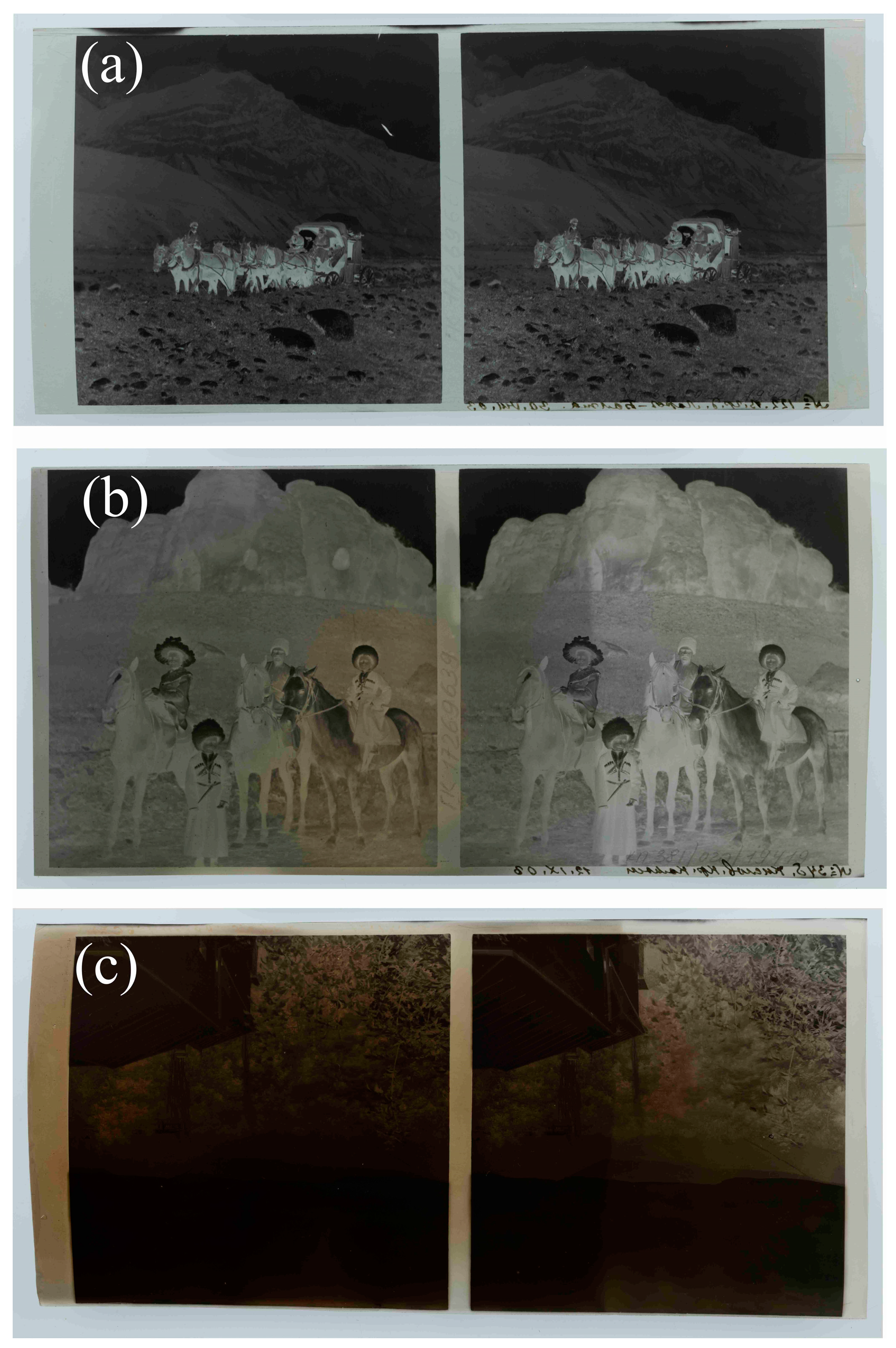
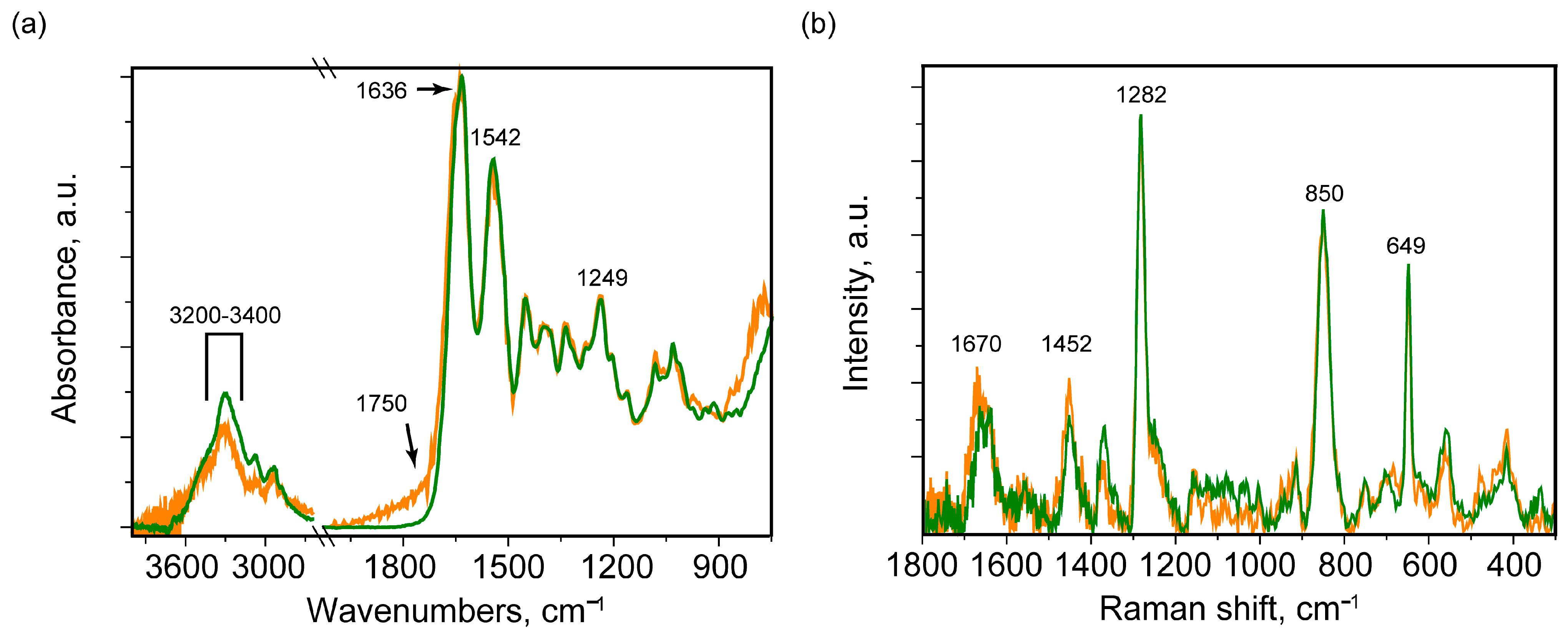
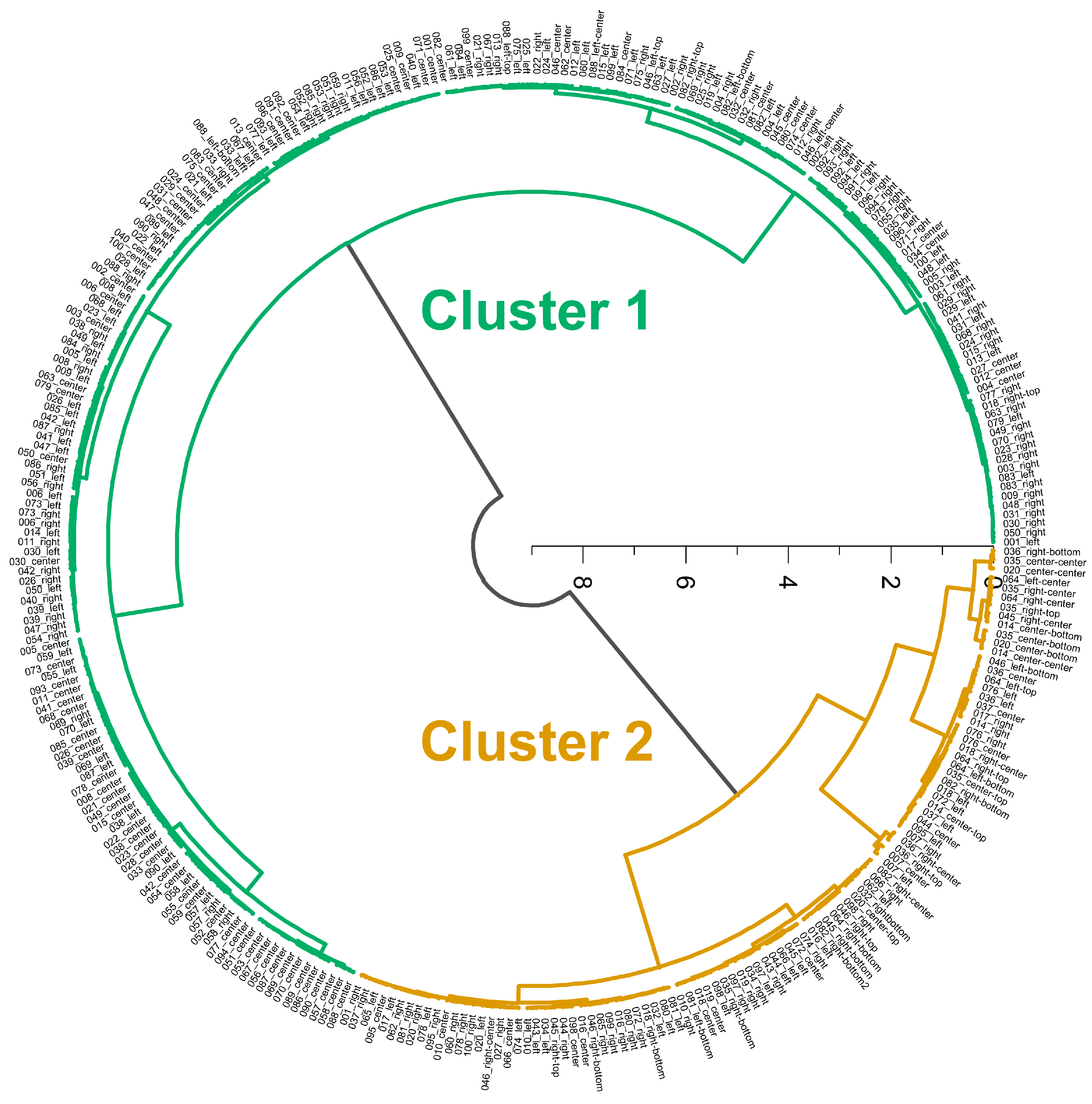
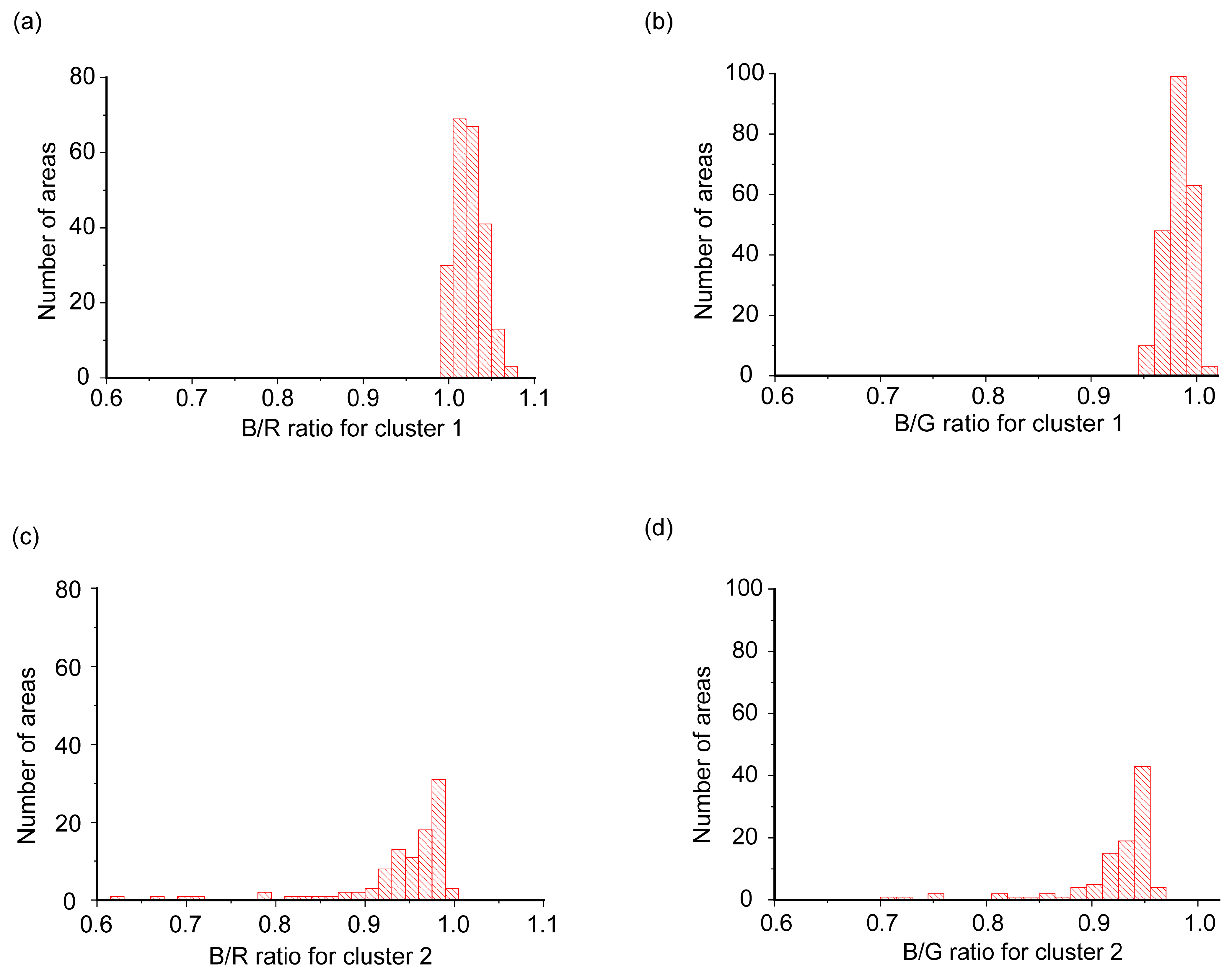
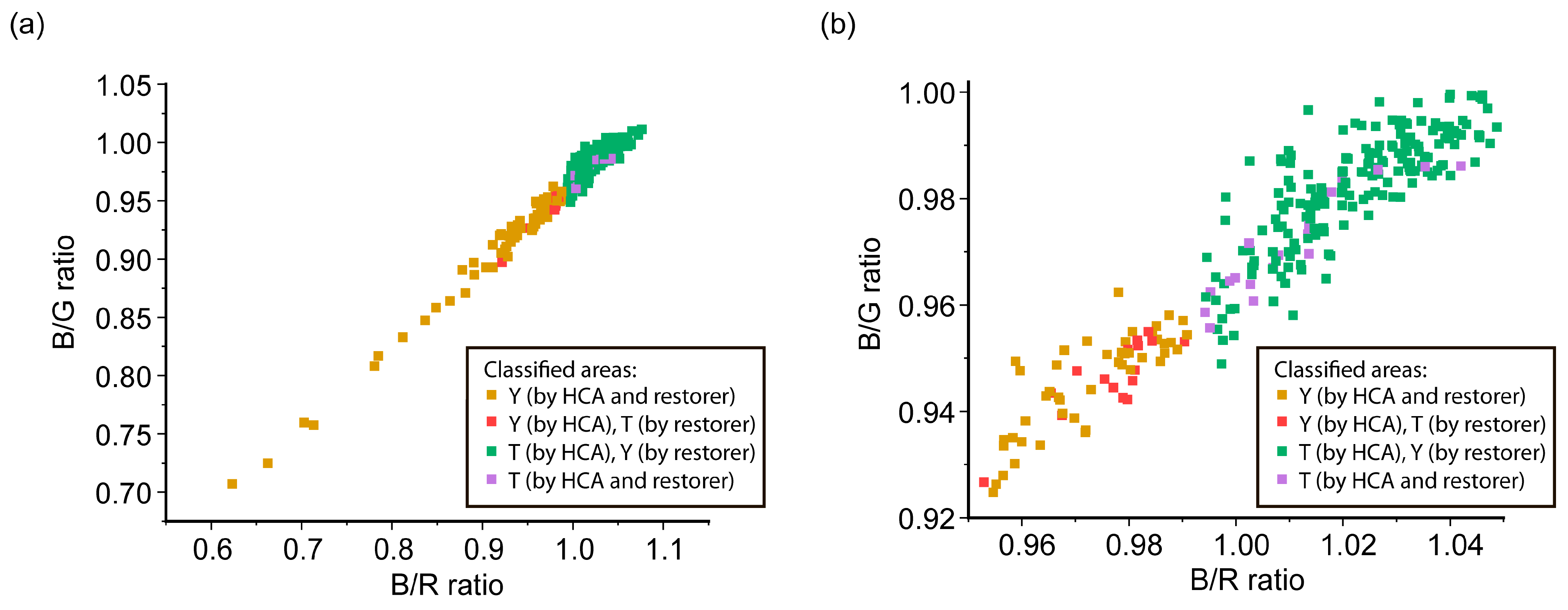


Disclaimer/Publisher’s Note: The statements, opinions and data contained in all publications are solely those of the individual author(s) and contributor(s) and not of MDPI and/or the editor(s). MDPI and/or the editor(s) disclaim responsibility for any injury to people or property resulting from any ideas, methods, instructions or products referred to in the content. |
© 2024 by the authors. Licensee MDPI, Basel, Switzerland. This article is an open access article distributed under the terms and conditions of the Creative Commons Attribution (CC BY) license (https://creativecommons.org/licenses/by/4.0/).
Share and Cite
Povolotckaia, A.; Kaputkina, S.; Grigorieva, I.; Pankin, D.; Borisov, E.; Vasileva, A.; Kaputkina, V.; Dynnikova, M. The Nitrate Cellulose Negatives: Degradation Study via Chemometric Methods. Heritage 2024, 7, 4712-4724. https://doi.org/10.3390/heritage7090223
Povolotckaia A, Kaputkina S, Grigorieva I, Pankin D, Borisov E, Vasileva A, Kaputkina V, Dynnikova M. The Nitrate Cellulose Negatives: Degradation Study via Chemometric Methods. Heritage. 2024; 7(9):4712-4724. https://doi.org/10.3390/heritage7090223
Chicago/Turabian StylePovolotckaia, Anastasia, Svetlana Kaputkina, Irina Grigorieva, Dmitrii Pankin, Evgenii Borisov, Anna Vasileva, Valeria Kaputkina, and Maria Dynnikova. 2024. "The Nitrate Cellulose Negatives: Degradation Study via Chemometric Methods" Heritage 7, no. 9: 4712-4724. https://doi.org/10.3390/heritage7090223





